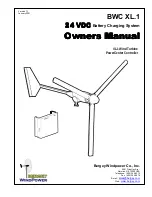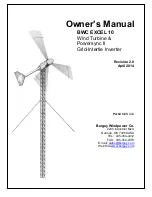
6
which allows the turbine to run unloaded. Under
unloaded operation the rotor will spin faster and it
will make more noise. In high winds the blades
may also “flutter”, causing a loud, low pitch growl-
ing sound.
The AutoFurl system works whether the turbine is
loaded or unloaded. Applying extra loads during
high wind periods can reduce the likelihood of
blade flutter.
D. PowerCenter Controller
The basic electrical schematic for the BWC XL.1
is shown in Figure 5. The XL.1’s alternator pro-
duces three-phase alternating current (AC) that
varies in voltage and frequency with the rotor
speed. The AC power is rectified to direct current
(DC) power by a rectifier module inside the na-
celle. Thus, the wire run from the wind turbine to
the PowerCenter is DC.
Alternator
Rectifier
(on turbine)
DC Wire Run
PowerCenter
Figure 5, XL.1 Basic Electrical Schematic
The PowerCenter for the XL.1 has two sets of
color-coded light-emitting-diodes (LED’s) for Sys-
tem Status and Battery Bank Status.
System Status Lights:
Solar Power
(green): Lights up when the op-
tional solar panel(s) are charging the batteries.
Extra Load
(red): Lights up when the optional
auxiliary or dump load is activated due to high
battery voltage.
Wind Power
(green): Lights up when the XL.1
wind turbine is charging the batteries.
Power Boost
(green): Lights up in low to
moderate winds to indicate that the low wind
speed performance optimizing boost circuitry is
operating.
Battery Bank Status Lights:
Battery bank charge status is shown with ten col-
ored LED’s, which act like a fuel gage for the re-
mote power system. This gage, however, is inex-
act and it is intended to provide only a general
indication of the energy reserves available in the
system. The following table shows the voltage
indicated by the highest lit LED and its approxi-
mate relationship to the battery capacity available.
LED No.
(from left
side)
Indicated
Battery
Voltage
Range
Approxi-
mate Bat-
tery Re-
serve
L1 (red)
Below 22 V
Below 5%
L2 (yellow)
22 – 23.5 V
5%
L3 (green)
23.5 – 24 V
15%
L4 (green)
24 – 24.5 V
30%
L5 (green)
24.5 – 25 V
60%
L6 (green)
25 – 27 V
90%
L7 (green)
27 – 28 V
100%
L8 (green)
28 – 29.5 V
100%
L9 (yellow)
29.5 – 30.5 V
100%
L10 (red)
Above 30.5 V
100%
Table 1, Battery Bank Status Indications
The LED’s provide an indication of the instanta-
neous battery voltage. This voltage is affected by
the state of battery charge and the instantaneous
net current flow into or out of the battery. There-
fore, during high charging/low load periods the
gage will over-predict battery state of charge and
during low charging/high load periods the gage
will under-predict battery state of charge. Also,
the smaller the battery bank the more rapidly the
LED’s will change in response to changing wind
and electrical load conditions.
The PowerCenter is designed to work with
flooded-cell or sealed, deep-cycle, lead-acid bat-
teries. Do not use other types of batteries without
first contacting Bergey Windpower Co.
Battery Equalization
The PowerCenter has an automatic one-hour bat-
tery equalization function that is initiated using the
push button on the back side of the PowerCenter
enclosure. Equalization is a maintenance function
that brings the batteries up to a higher state of
charge and causes them to out-gas (bubble) ac-
Summary of Contents for 24 VDC B
Page 19: ...18 Appendices ...























